Abstract
Forty-two subjects with acute tularemia were studied for the occurrence of C-reactive protein (CRP), and 73 subjects with acute tularemia or experience of the disease within the last 11 years were studied for immunoglobulin M (IgM), IgA, and IgG class-specific antibodies, agglutinating antibodies, and complement-fixing antibodies to Francisella tularensis by using an enzyme-linked immunosorbent assay (ELISA), the tube agglutination test, and a complement-fixing ELISA. The incubation time between infection and the outbreak of symptoms varied from 1 to 10 days, averaging 6.5 days. Elevated CRP concentrations were found in all samples taken in the first 6 days of illness, when the antibodies generally were absent. The highest CRP values, up to 165 mg/liter, occurred in the earliest samples and then decreased rapidly, being undetectable (less than 1 mg/liter) from 1 month after the onset of symptoms. Simultaneous though individually varying formation of IgM, IgA, and IgG class-specific antibodies to F. tularensis was demonstrable by ELISA in all the tularemia patients during the acute stage. In most cases, these antibodies appeared 6 to 10 days after the onset of symptoms, i.e., about 2 weeks after infection, reached their highest values at 4 to 7 weeks, and, despite a decreasing trend in their level, were still present 0.5 to 11 years after onset of tularemia, as demonstrable by the agglutination test and by the complement-fixing ELISA. Of the three methods used, ELISA for IgM, IgA, and IgG proved to be the most efficient for the early serodiagnosis of tularemia.
Full text
PDF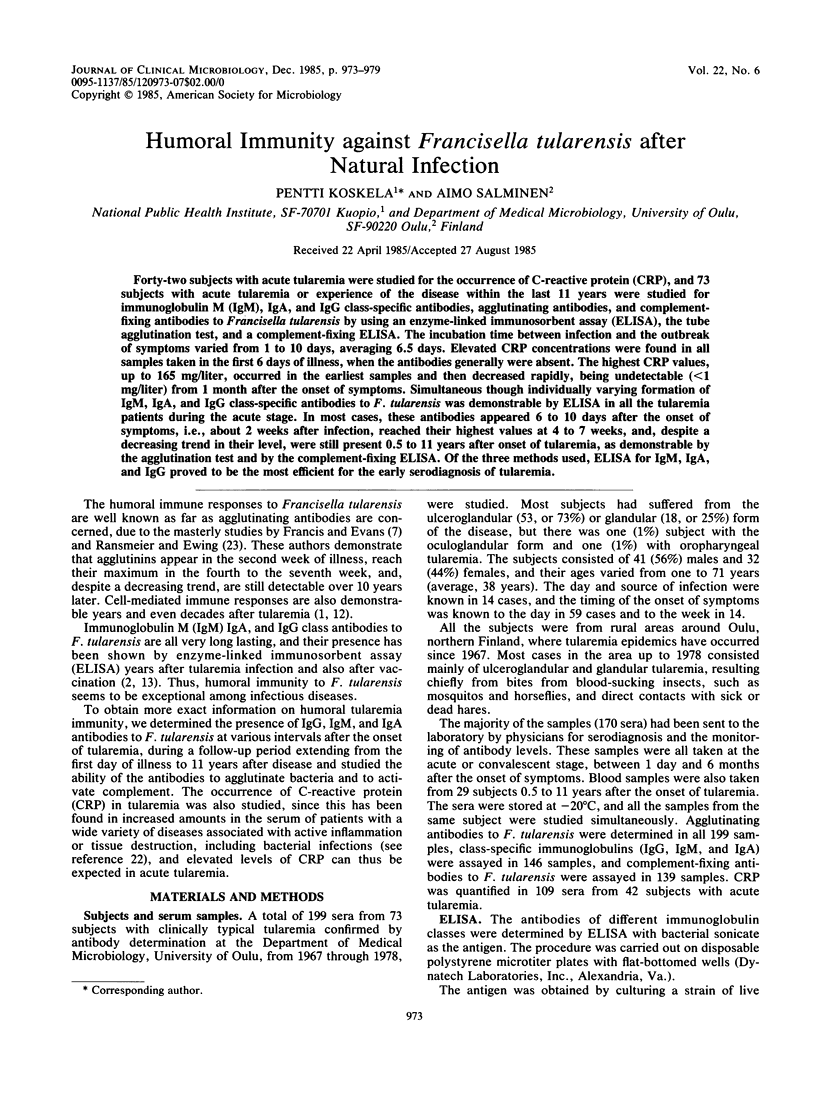
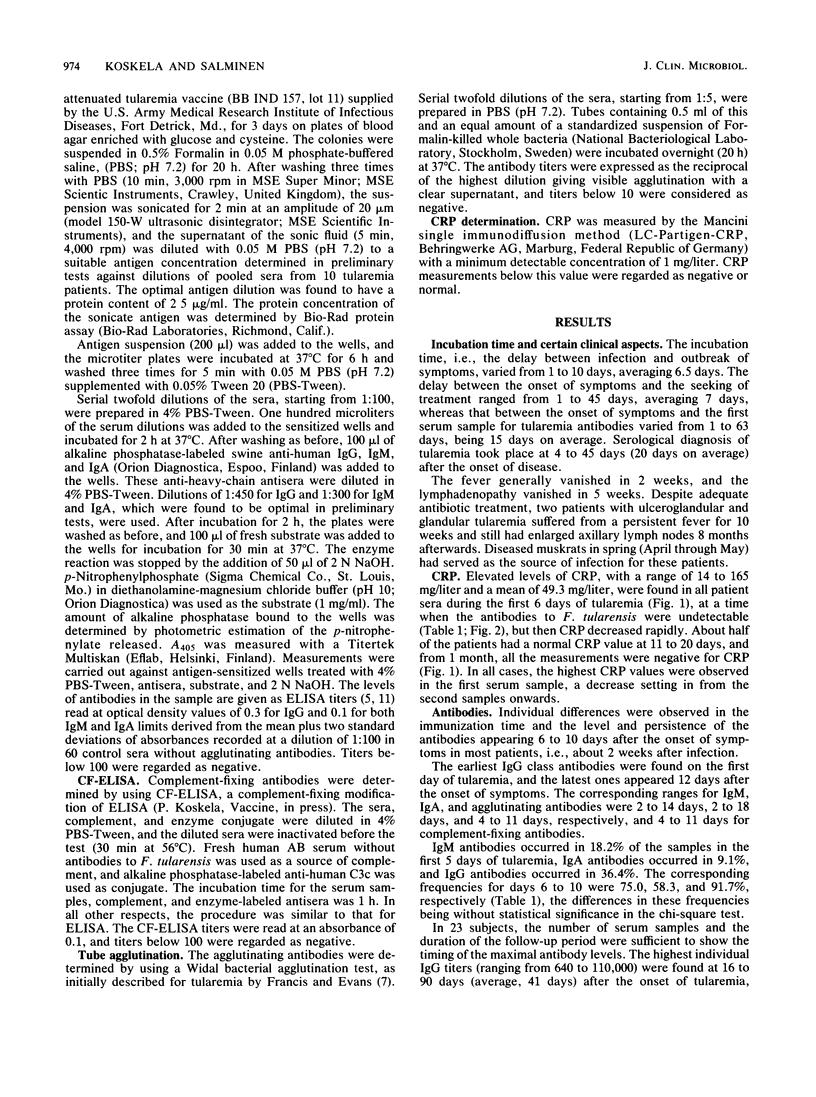
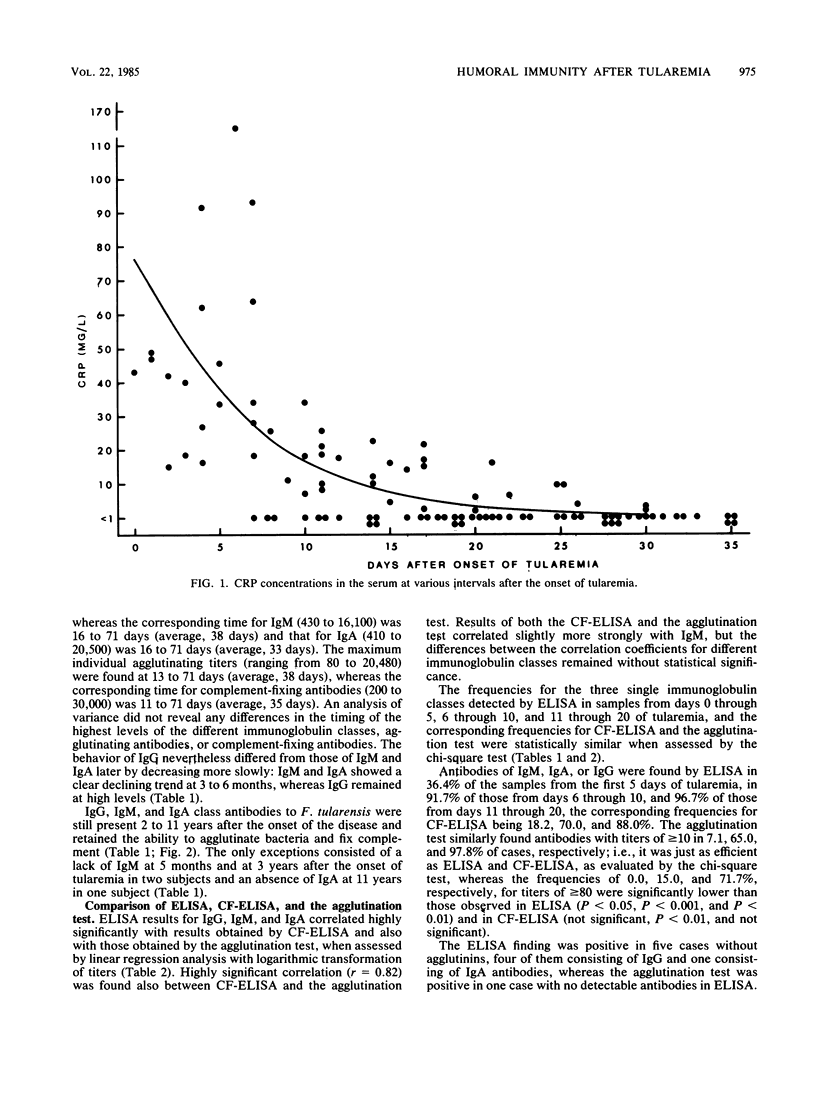
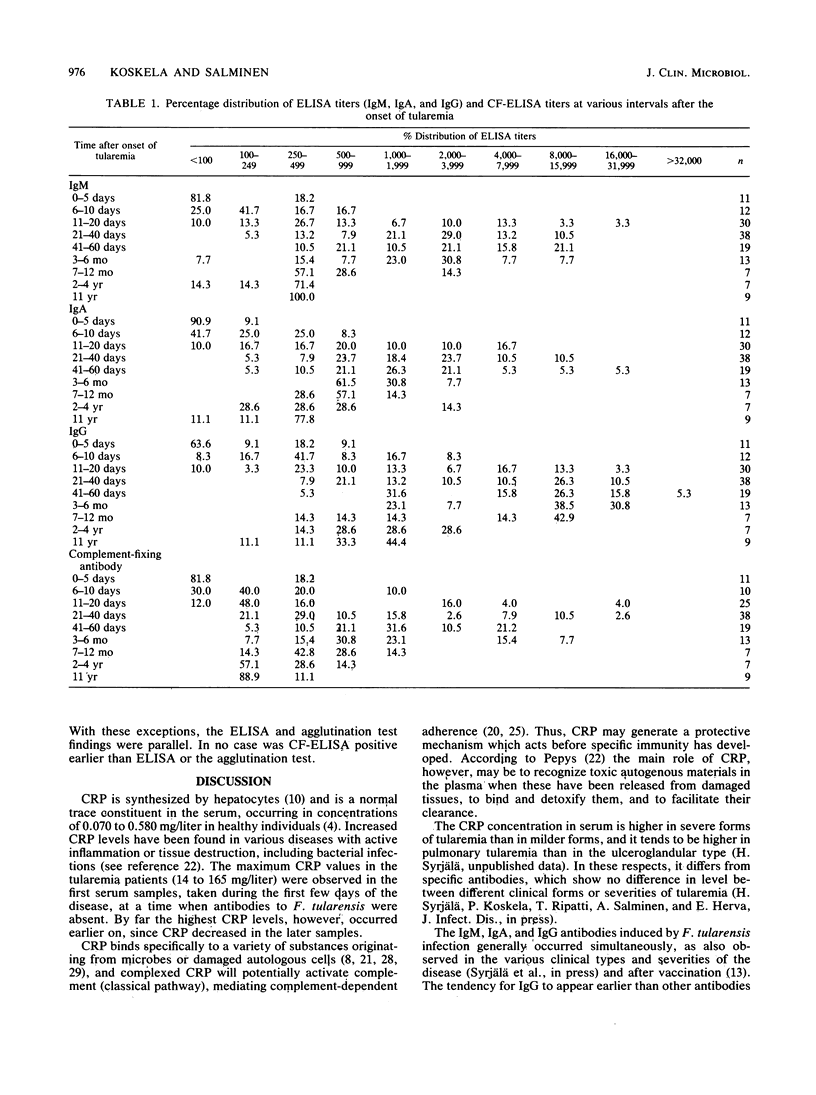
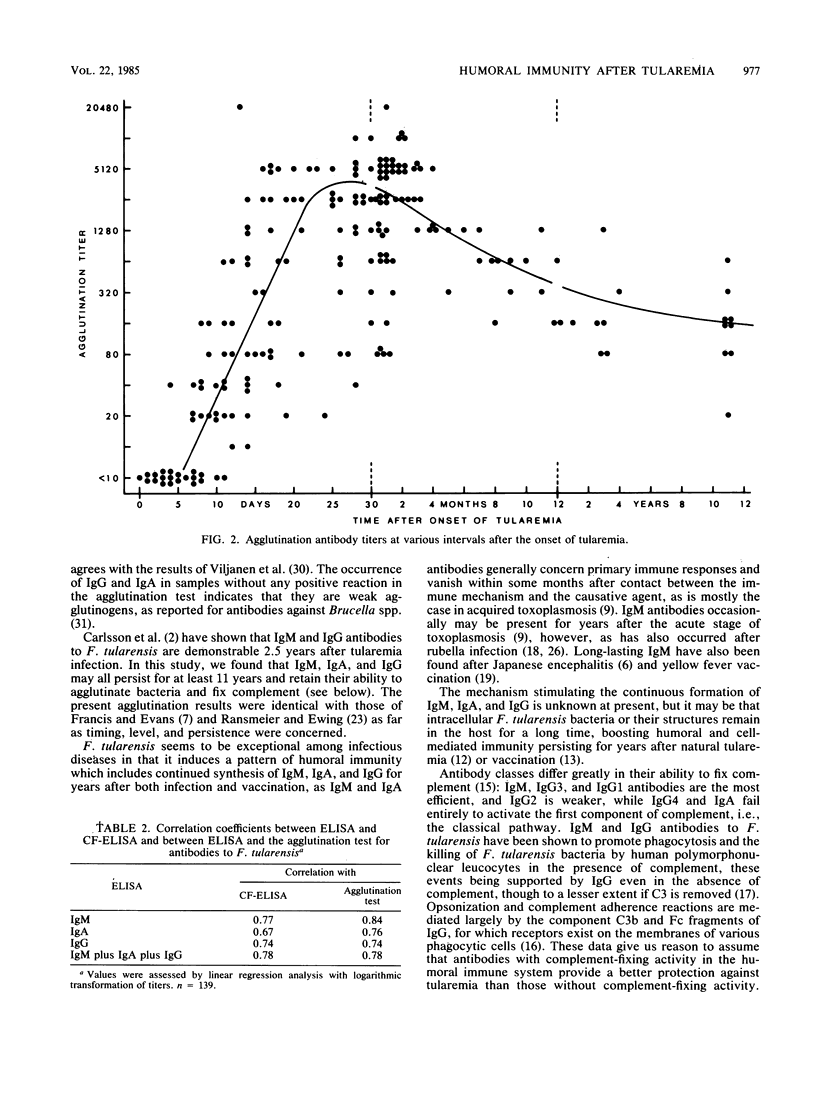
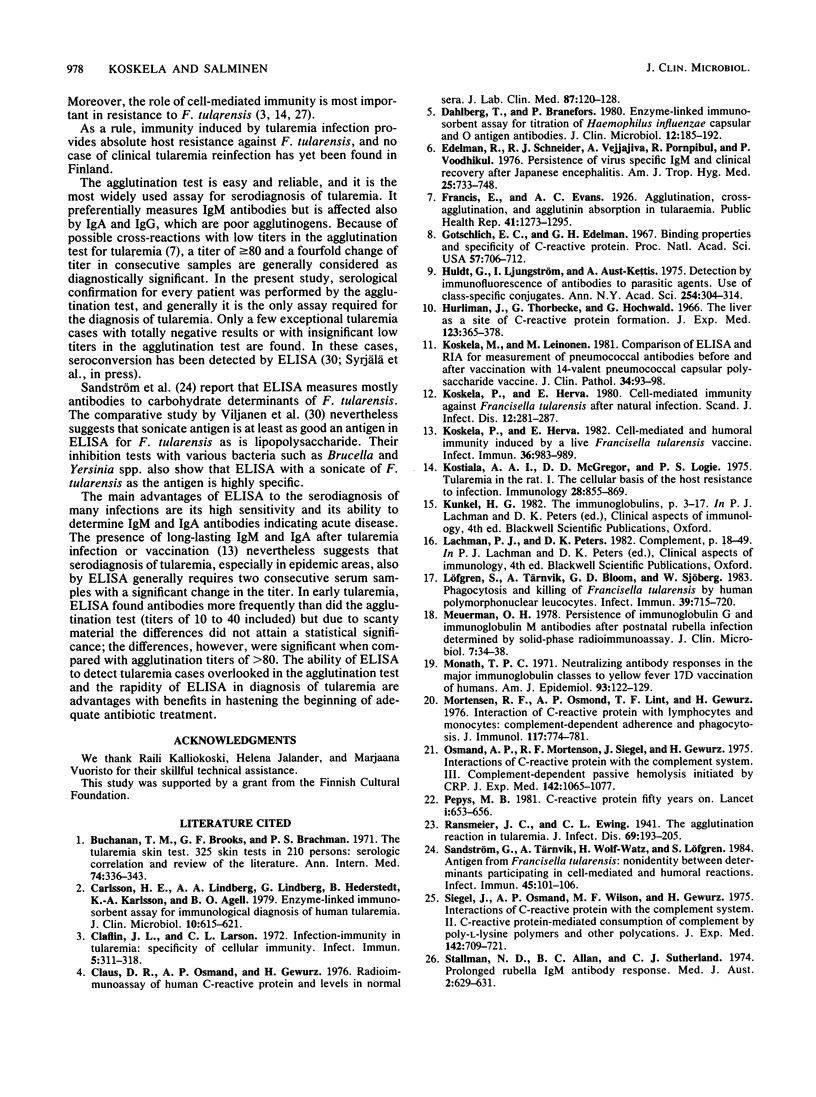
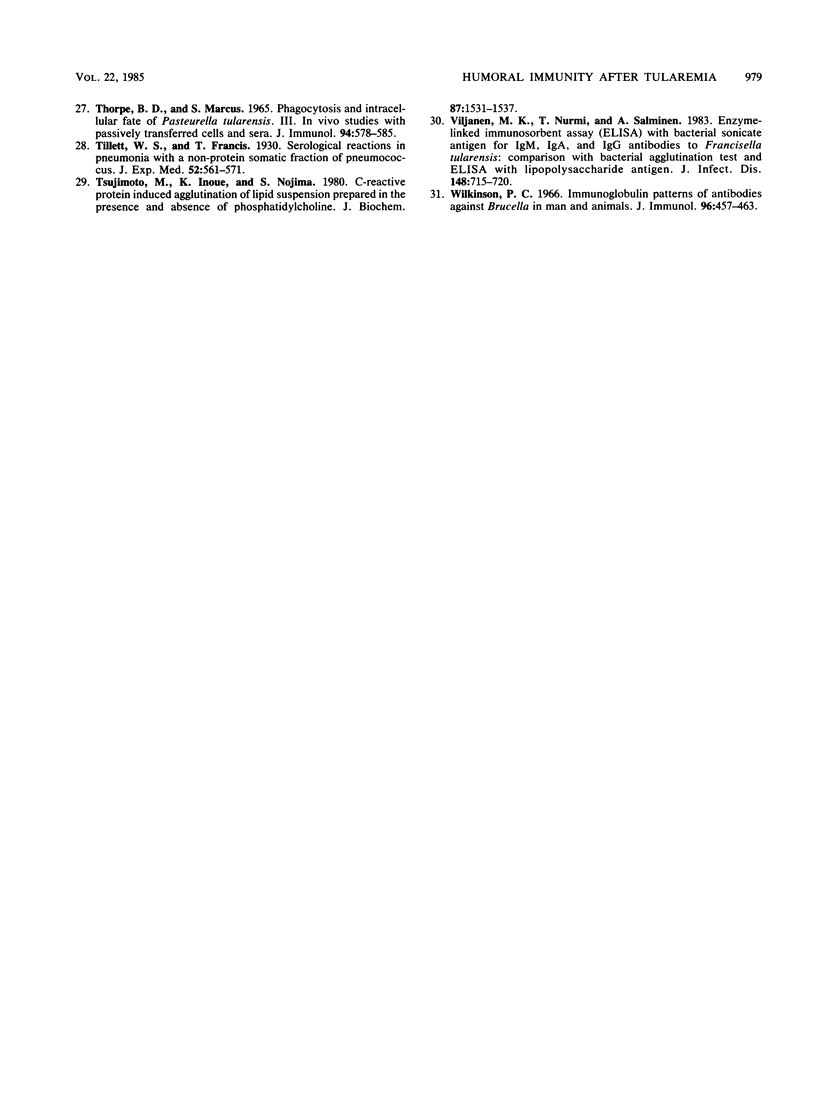
Selected References
These references are in PubMed. This may not be the complete list of references from this article.
- Buchanan T. M., Brooks G. F., Brachman P. S. The tularemia skin test. 325 skin tests in 210 persons: serologic correlation and review of the literature. Ann Intern Med. 1971 Mar;74(3):336–343. doi: 10.7326/0003-4819-74-3-336. [DOI] [PubMed] [Google Scholar]
- Carlsson H. E., Lindberg A. A., Lindberg G., Hederstedt B., Karlsson K. A., Agell B. O. Enzyme-linked immunosorbent assay for immunological diagnosis of human tularemia. J Clin Microbiol. 1979 Nov;10(5):615–621. doi: 10.1128/jcm.10.5.615-621.1979. [DOI] [PMC free article] [PubMed] [Google Scholar]
- Claflin J. L., Larson C. L. Infection-immunity in tularemia: specificity of cellular immunity. Infect Immun. 1972 Mar;5(3):311–318. doi: 10.1128/iai.5.3.311-318.1972. [DOI] [PMC free article] [PubMed] [Google Scholar]
- Claus D. R., Osmand A. P., Gewurz H. Radioimmunoassay of human C-reactive protein and levels in normal sera. J Lab Clin Med. 1976 Jan;87(1):120–128. [PubMed] [Google Scholar]
- Dahlberg T., Branefors P. Enzyme-linked immunosorbent assay for titration of Haemophilus influenzae capsular and O antigen antibodies. J Clin Microbiol. 1980 Aug;12(2):185–192. doi: 10.1128/jcm.12.2.185-192.1980. [DOI] [PMC free article] [PubMed] [Google Scholar]
- Edelman R., Schneider R. J., Vejjajiva A., Pornpibul R., Voodhikul P. Persistence of virus-specific IgM and clinical recovery after Japanese encephalitis. Am J Trop Med Hyg. 1976 Sep;25(5):733–738. doi: 10.4269/ajtmh.1976.25.733. [DOI] [PubMed] [Google Scholar]
- Gotschlich E. C., Edelman G. M. Binding properties and specificity of C-reactive protein. Proc Natl Acad Sci U S A. 1967 Mar;57(3):706–712. doi: 10.1073/pnas.57.3.706. [DOI] [PMC free article] [PubMed] [Google Scholar]
- Huldt G., Ljungström I., Aust-Kettis A. Detection by immunofluorescence of antibodies to parasitic agents. Use of class-specific conjugates. Ann N Y Acad Sci. 1975 Jun 30;254:304–314. doi: 10.1111/j.1749-6632.1975.tb29180.x. [DOI] [PubMed] [Google Scholar]
- Hurlimann J., Thorbecke G. J., Hochwald G. M. The liver as the site of C-reactive protein formation. J Exp Med. 1966 Feb 1;123(2):365–378. doi: 10.1084/jem.123.2.365. [DOI] [PMC free article] [PubMed] [Google Scholar]
- Interactions of C-reactive protein with the complement system. III. Complement-dependent passive hemolysis initiated by CRP. J Exp Med. 1975 Nov 1;142(5):1065–1077. doi: 10.1084/jem.142.5.1065. [DOI] [PMC free article] [PubMed] [Google Scholar]
- Koskela M., Leinonen M. Comparison of ELISA and RIA for measurement of pneumococcal antibodies before and after vaccination with 14-valent pneumococcal capsular polysaccharide vaccine. J Clin Pathol. 1981 Jan;34(1):93–98. doi: 10.1136/jcp.34.1.93. [DOI] [PMC free article] [PubMed] [Google Scholar]
- Koskela P., Herva E. Cell-mediated and humoral immunity induced by a live Francisella tularensis vaccine. Infect Immun. 1982 Jun;36(3):983–989. doi: 10.1128/iai.36.3.983-989.1982. [DOI] [PMC free article] [PubMed] [Google Scholar]
- Koskela P., Herva E. Cell-mediated immunity against Francisella tularensis after natural infection. Scand J Infect Dis. 1980;12(4):281–287. doi: 10.3109/inf.1980.12.issue-4.08. [DOI] [PubMed] [Google Scholar]
- Kostiala A. A., McGregor D. D., Logie P. S. Tularaemia in the rat. I. The cellular basis on host resistance to infection. Immunology. 1975 May;28(5):855–869. [PMC free article] [PubMed] [Google Scholar]
- Löfgren S., Tärnvik A., Bloom G. D., Sjöberg W. Phagocytosis and killing of Francisella tularensis by human polymorphonuclear leukocytes. Infect Immun. 1983 Feb;39(2):715–720. doi: 10.1128/iai.39.2.715-720.1983. [DOI] [PMC free article] [PubMed] [Google Scholar]
- Meurman O. H. Persistence of immunoglobulin G and immunoglobulin M antibodies after postnatal rubella infection determined by solid-phase radioimmunoassay. J Clin Microbiol. 1978 Jan;7(1):34–38. doi: 10.1128/jcm.7.1.34-38.1978. [DOI] [PMC free article] [PubMed] [Google Scholar]
- Monath T. P. Neutralizing antibody responses in the major immunoglobulin classes to yellow fever 17D vaccination of humans. Am J Epidemiol. 1971 Feb;93(2):122–129. doi: 10.1093/oxfordjournals.aje.a121232. [DOI] [PubMed] [Google Scholar]
- Mortensen R. F., Osmand A. P., Lint T. F., Gewurz H. Interaction of C-reactive protein with lymphocytes and monocytes: complement-dependent adherence and phagocytosis. J Immunol. 1976 Sep;117(3):774–781. [PubMed] [Google Scholar]
- Pepys M. B. C-reactive protein fifty years on. Lancet. 1981 Mar 21;1(8221):653–657. doi: 10.1016/s0140-6736(81)91565-8. [DOI] [PubMed] [Google Scholar]
- Public Health Weekly Reports for JUNE 25, 1926. Public Health Rep. 1926 Jun 25;41(26):1273–1339. [PMC free article] [PubMed] [Google Scholar]
- Sandström G., Tärnvik A., Wolf-Watz H., Löfgren S. Antigen from Francisella tularensis: nonidentity between determinants participating in cell-mediated and humoral reactions. Infect Immun. 1984 Jul;45(1):101–106. doi: 10.1128/iai.45.1.101-106.1984. [DOI] [PMC free article] [PubMed] [Google Scholar]
- Siegel J., Osmand A. P., Wilson M. F., Gewurz H. Interactions of C-reactive protein with the complement system. II. C-reactive protein-mediated consumption of complement by poly-L-lysine polymers and other polycations. J Exp Med. 1975 Sep 1;142(3):709–721. doi: 10.1084/jem.142.3.709. [DOI] [PMC free article] [PubMed] [Google Scholar]
- Stallman N. D., Allan B. C., Sutherland C. J. Prolonged rubella IgM antibody response. Med J Aust. 1974 Oct 26;2(17):629–631. [PubMed] [Google Scholar]
- THORPE B. D., MARCUS S. PHAGOCYTOSIS AND INTRACELLULAR FATE OF PASTEURELLA TULARENSIS. 3. IN VIVO STUDIES WITH PASSIVELY TRANSFERRED CELLS AND SERA. J Immunol. 1965 Apr;94:578–585. [PubMed] [Google Scholar]
- Tsujimoto M., Inoue K., Nojima S. C-Reactive protein induced agglutination of lipid suspensions prepared in the presence and absence of phosphatidylcholine. J Biochem. 1980 May;87(5):1531–1537. doi: 10.1093/oxfordjournals.jbchem.a132894. [DOI] [PubMed] [Google Scholar]
- Viljanen M. K., Nurmi T., Salminen A. Enzyme-linked immunosorbent assay (ELISA) with bacterial sonicate antigen for IgM, IgA, and IgG antibodies to Francisella tularensis: comparison with bacterial agglutination test and ELISA with lipopolysaccharide antigen. J Infect Dis. 1983 Oct;148(4):715–720. doi: 10.1093/infdis/148.4.715. [DOI] [PubMed] [Google Scholar]
- Wilkinson P. C. Immunoglobulin patterns of antibodies against Brucella in man and animals. J Immunol. 1966 Mar;96(3):457–463. [PubMed] [Google Scholar]


